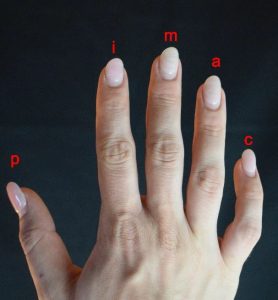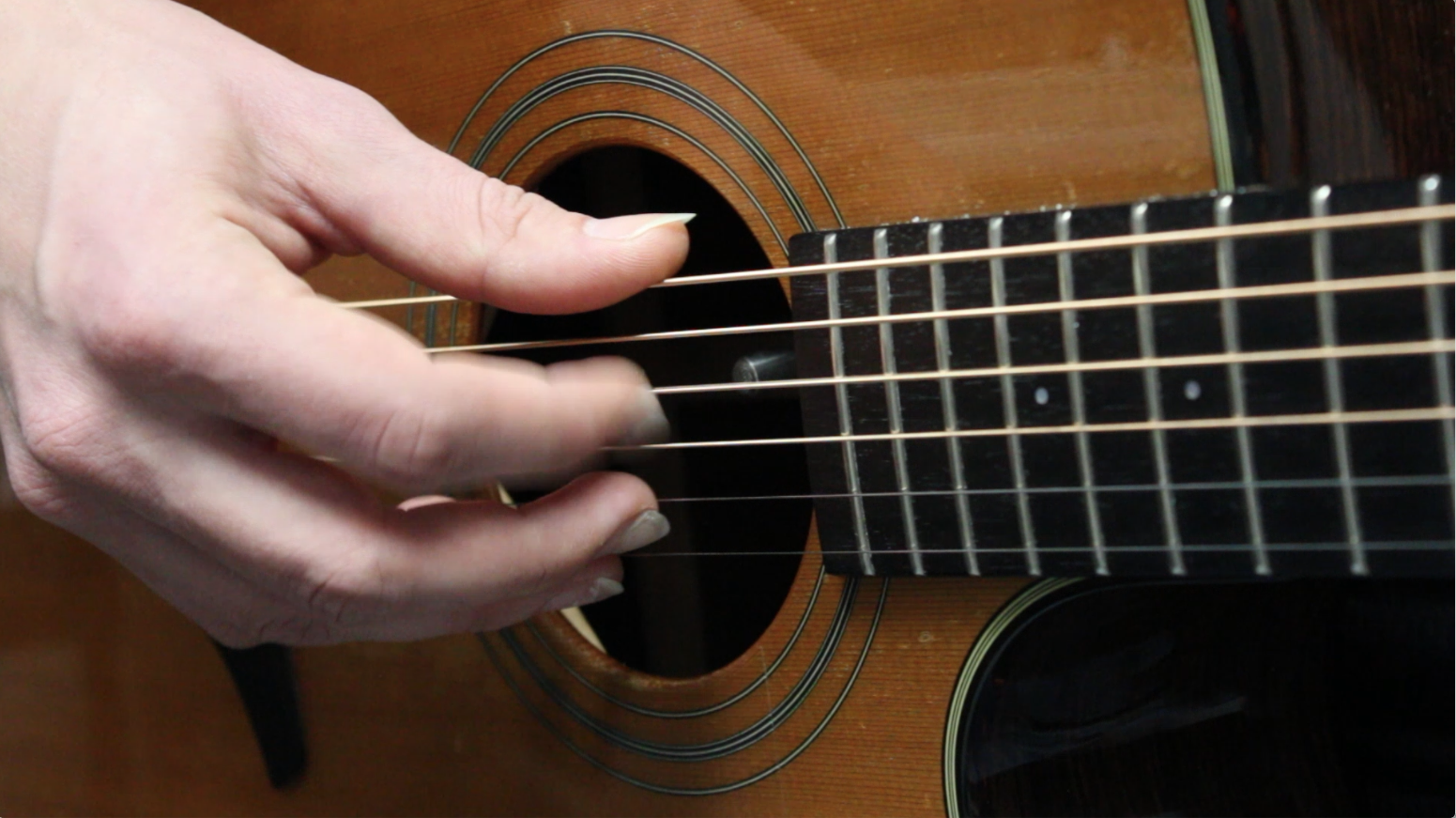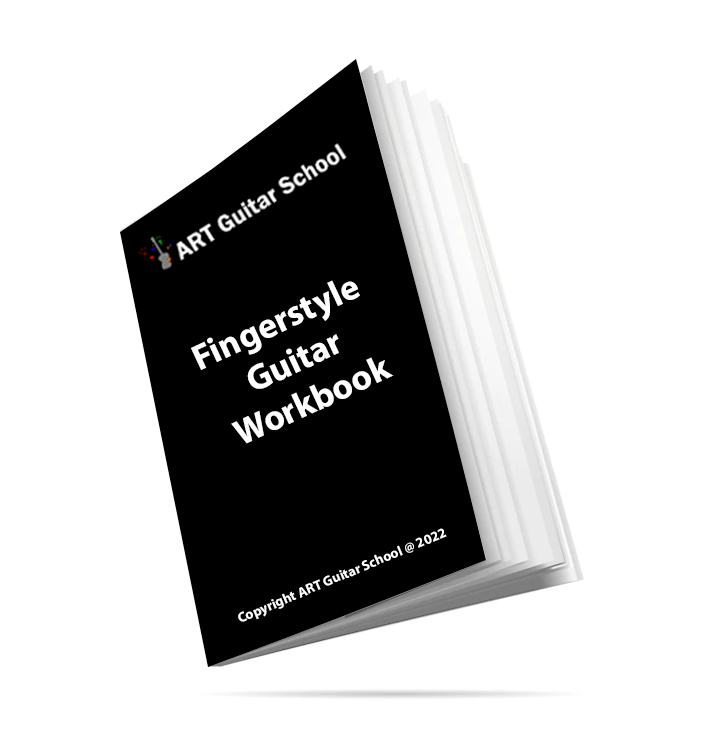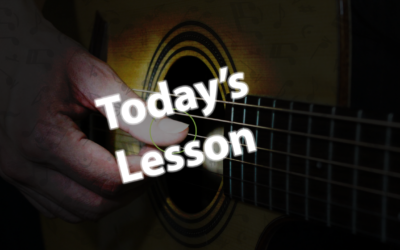FINGERPICKING KEY

The right hand:
P = Thumb
I = Index
M = Middle
A = Ring
Fingerpicking Pattern No. 1
This is the most essential fingerpicking pattern to start with. It requires no left hand chord or fretted notes. It is used in many popular fingerpicking songs and some songs are slight variations of this same pattern.
We have all open strings being plucked in sequential order. Each note is a quarter note in duration and will last exactly one second each if played at 60bpm.
Lets get to playing!
We will pluck each open string in order starting from the 6th string (Low E) and ending on the 1st (High E).
Step 1. Lets start with thumb (p) and pluck the 6th-4th string
Step 2. Pluck index (i), middle (m) and ring (a) on the 3rd-1st strings.

Here is a video demonstration of the finger picking pattern:
If you were having trouble please contact us and we will help you!
FOLLOW US ON
Get our FREE Fingerstyle Workbook!
RELATED BLOG POSTS
Fingerstyle Guitar: 5 Common Mistakes and How to Avoid Them
Fingerstyle guitar is rewarding but can come with a few growing pains. Here are five common mistakes beginners make and how to fix them:
1. Inconsistent Thumb Control
The thumb controls the bass notes, but beginners often struggle with precision. Practice playing just the bass notes to improve control.
2. Improper Finger Placement
Weak or muted strings can result from poor finger placement. Keep your fingers naturally curled and avoid splaying them out.
3. Rushing Through Patterns
It’s tempting to speed up, but slow down your practice. Accuracy comes first, and speed will follow with time.
4. Too Much Tension
Tension limits flexibility and causes strain. Relax your hand, wrist, and fingers for better control and speed.
5. Not Using the Right Nails
Nails are key for a bright sound and control. If necessary, grow your nails slightly or use fingerpicks to enhance your playing.
Getting Started with Fingerstyle Guitar: A Beginner’s Guide
Welcome to the world of fingerstyle guitar! If you’re new to guitar, you’ve probably seen players creating beautiful music without a pick, using just their fingers. Wondering where to start? Here’s your beginner guide to fingerstyle guitar!
1. Hand Positioning
The first step to learning fingerstyle is understanding hand positioning. Hold your guitar with your thumb lightly resting on the low E string and your fingers hovering over the higher strings (D, G, B, and high E). Your thumb controls the bass notes, while your fingers handle the melody.
2. Basic Fingerpicking Patterns
The Travis Picking pattern is a popular fingerpicking style for beginners. Here’s a basic example:
Thumb (P) – 6th string (E)
Index (I) – 3rd string (G)
Thumb (P) – 4th string (D)
Middle (M) – 2nd string (B)
3. Your First Fingerstyle Song
Once you get the hang of basic picking patterns, try “Dust in the Wind” by Kansas. It’s perfect for beginners with a simple pattern and a beautiful melody. Start slow, focus on accuracy, and soon you’ll be playing full songs!
The Ultimate Beginner’s Guide to Fingerstyle Guitar
Welcome to the world of fingerstyle guitar! If you’re new to guitar, you’ve probably seen players making amazing music without a pick, using just their fingers to create beautiful sounds. But where do you start?
Hand Positioning: The first step to learning fingerstyle is understanding hand positioning. Hold your guitar so your thumb rests lightly on the low E string, and your fingers are hovering over the higher strings (D, G, B, and high E). Your thumb will generally control the bass notes (on the lower strings), while your fingers pick the melody (on the higher strings).
Basic Fingerpicking Patterns: The most common fingerpicking pattern is called the Travis Picking pattern, where the thumb alternates between bass notes (usually on the E, A, and D strings) while the index and middle fingers pick the higher strings. Here’s a basic example:
Thumb (P) – 6th string (E)
Index (I) – 3rd string (G)
Thumb (P) – 4th string (D)
Middle (M) – 2nd string (B)
First Fingerstyle Song: Once you get the hang of basic picking patterns, you can try your first simple fingerstyle song. A great one for beginners is “Dust in the Wind” by Kansas. It uses a simple pattern and a beautiful melody to help get your fingers accustomed to the flow of fingerstyle.
Start slow, focus on accuracy, and build your confidence with these techniques. Before you know it, you’ll be playing full songs with ease!




0 Comments